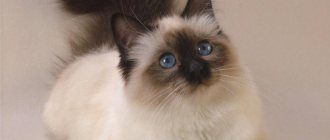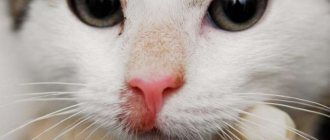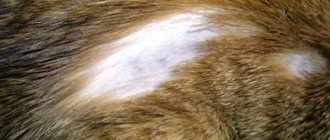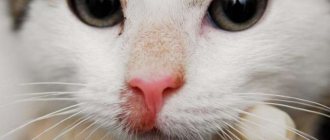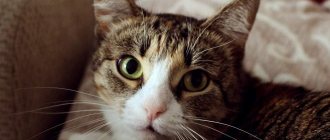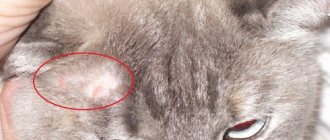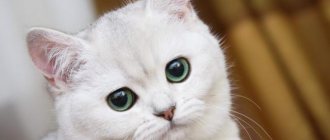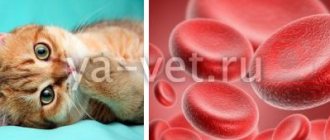Ringworm in cats is a fungal infection of an animal. What is the cause of the disease? In the first place is infection. Reduced immunity, allergies, and viruses are also prerequisites for the disease. More recently, 20 years ago, even 10 years ago, the disease was considered incurable. Pets were euthanized. Fortunately, today lichen in cats and kittens can be treated. The disease is contagious; it can infect other animals and, which is very unpleasant, people.
It is necessary to be vigilant and at the first signs of deprivation (we will talk about them a little later) not to self-medicate, but, having grabbed your pet, come to an appointment with a veterinarian for an accurate diagnosis. Many people encounter this for the first time, panic, search on forums, ask friends what to do? Yes, you can listen to advice, but! you should calm down and come with your cat to a doctor's consultation. By being patient and receiving the necessary treatment methods, you can help your pet recover.
In the article we will talk about the types of ringworm, its symptoms, and will dwell in more detail on the treatment of ringworm and prevention.
Types of lichen
There are several types of lichen. They differ not only in external signs, but are also treated differently.
- Lichen planus;
- Pink or herpes zoster;
- Ringworm or eczema;
- Pityriasis versicolor;
- Ringworm.
Lichen planus is characterized by the appearance of red blisters on the cat's skin. It itches constantly, the blisters burst, causing severe itching. Red bubbles appear in the groin, abdomen, and on the bends of the joints. The mucous membranes are affected. This type of lichen in a cat signals that not everything is ok with the immune system. The good news is that this shingles is not spread to other animals or people.
Pityriasis rosea in a cat is a sign of a viral infection. How does it manifest itself? Pink spots ranging in size from 1.5 to 2 cm appear on the animal’s body. The cat itches and the skin peels off. Then the stain becomes crusty. Ringworm usually goes away on its own. During the period of exacerbation, the animal should not be washed or released into the sun. You need to take care of his healthy diet. There is no consensus in the scientific world about whether pityriasis rosea in cats is dangerous or not.
With weeping lichen, red bubbles appear, filled with liquid, which are very painful. Ringworm or eczema is rare. The disease can be caused by a malfunction in the immune system, the presence of parasites, allergies to food and detergents. This type of lichen is not contagious.
Let's look at what pityriasis versicolor (varicolored) lichen in cats is. This type of lichen is very contagious for humans and is easily transmitted to other animals. It is also called “sun fungus” and “beach lichen”. Oval spots of pink, brown, pale yellow color appear on your pet's body, growing very quickly. Pityriasis versicolor requires long-term and serious treatment.
Ringworm
Lichen planus in cats is a concept transferred to veterinary medicine from human medicine. This disease is not considered in cats. As a rule, this refers to non-infectious, chronic dermatitis caused by allergies or a malfunction of the immune system. May occur after infectious diseases.
Symptoms of red lichen
The symptoms of ringworm in cats resemble eczema, with the only difference being that the surface of the skin is dry. Reddish plaques form on the skin. At first these are small spots, which as the disease progresses form a large spot. Plaques are located in the groin, joints and abdomen.
Treatment of red lichen
There is no effective treatment for ringworm in cats, either at home or in the clinic. Medications are used to relieve symptoms and itching.
Ringworm
Now let’s take a closer look at what ringworm is in a cat. It is one of the most dangerous and common types of lichen. What is the danger and insidiousness of this disease? The fact is that the incubation period for lichen in cats can last from several days to several months. Other animals and unsuspecting people become infected. It is especially dangerous for long-haired breeds, since the hair prevents the first signs of the disease from being seen. How to treat ringworm in cats will be discussed a little later.
Let's consider what is the causative agent of ringworm? These are dermatophyte molds. There are two forms of ringworm:
- - microsporia;
- - trichyphytosis.
- What happens with microsporia?
- - hair fragility appears at the skin level;
- - wool hair is easily pulled out.
When hair falls out, other animals and people become infected with fungal spores.
Trichophytosis, the second form of the fungus, is very rare. With this type of ringworm, baldness appears only in the head and neck area.
There are three forms of the disease:
- -superficial;
- -deep;
- -atypical.
With a superficial and atypical form of ringworm in cats, for a long time it is impossible to notice that the disease process has already begun.
It is very important to identify the disease at an early stage; the method and time of treatment for your pet will depend on this.
Who is at risk and can get ringworm?
- -most often these are small kittens;
- - long-haired breeds (genetically predisposed to such diseases);
- - cats with malignant processes in the body;
- - cats infected with parasites;
- -young cats up to one year of age.
One of the most pressing and exciting questions is how is lichen transmitted from cats? Unfortunately, ringworm is contagious to humans. You love your pet, pet it, pick it up. Yes, usually upon contact the process of lichen infection occurs. This happens especially easily if there are scratches, wounds, or abrasions on your hands. You can become infected by dandruff, scales, and hair falling from a cat. Children can become infected very easily while playing in the sandbox. Your home, bowls, rugs, combs, etc. are contaminated. Fungal spores are very stable and viable. Will the person get sick or not? It depends on the type of lichen and the person’s immunity. Children and people with weakened immune systems are at risk.
Treatment of the disease
If ringworm is confirmed in your animal, your doctor will prescribe treatment. For small lesions, antifungal ointments are used, and for large lesions, oral medications are used. The most commonly prescribed treatment is as follows:
1 The hair on the infected area is cut for convenient application of drugs.
Long-haired cats are recommended to be completely clipped.
2 Carry out all manipulations with gloves to prevent infection. Be sure to boil the scissors you used to touch the wool.
3 It is recommended to wash the cat with a special antifungal shampoo . Popular shampoos are Nizoral and Sibazol, they can be purchased at a regular pharmacy. The principle of shampoos is based on the fact that they slow down the growth of fungi and prevent the growth of their cell wall.
The animal should not lick shampoos. Before taking, consult your veterinarian.
4If you have not bathed your cat with shampoo, treat the affected skin with any antiseptic. You can use 5-10% solutions of iodine or salicylic acid.
Several more treatment options
5The basis of treatment is prescribed antifungal ointments - Fungin, Clotrimazole, Miconazole, Sanoderm, Exoderil and their analogues. All these drugs are available in the form of a cream or gel, and may also be drops or spray, for example Fungin . Fungin is applied according to the proportion of 0.2-0.3 ml per 1 kg of animal weight for 10-15 days. This recommendation must be strictly followed; this is a fast-acting remedy, but very toxic. Clotrimazole, Mycosparin, Clotrisal, Sanoderm, Miconazole ointment or cream is rubbed into the area with pathology 2 times a day. The course of treatment is 2-4 weeks. Exoderil, Lamisil, Yam can be applied once a day until complete recovery.
Drugs for fungal infections that can be used to treat cats
6The doctor may prescribe broad-spectrum vaccines . They are injected subcutaneously into the animal's withers. The most effective vaccines are Polivac, Vakderm, Microderm.
Injecting the vaccine into the animal's withers
7If the disease has reached a large scale, affecting a large part of the body and nails, oral medications . The most common and highly effective drugs in this segment are Intraconazole, Ketoconazole, Flucanazole.
All antifungal tablets are prohibited for small kittens, lactating and pregnant cats. The tablets can be purchased at a regular pharmacy, they are also drugs for people, so your veterinarian will tell you the dosage for cats.
8 Place a sick pet in quarantine , protect it from children and other animals.
How to treat other types of lichen?
1 Pityriasis rosea goes away on its own in cats. It is necessary to take steps to increase immunity and reduce itching. Antihistamines Allervit, Promethazine can be used. It is strictly forbidden to bathe the animal; a humid environment contributes to the progression of the pathology.
Progressive pityriasis rosea
2 Lichen planus is also a malfunction of the immune system and does not require special local treatment. You can reduce itching and use antihistamines, as with pityriasis rosea.
Lichen planus
3 Pityriasis versicolor , or as it is also called versicolor, is treated with local antifungal drugs and shampoos. It passes quickly, but is also dangerous for humans and other animals.
Pityriasis versicolor in cats
4 Ringworm is very difficult to cure. It is necessary to treat the area daily with drying ointments based on natural ingredients - salicylic, ichthyol, tar ointment.
Ringworm
Traditional methods
On the Internet you can find dozens of “effective” tips for treating lichen. You can brew nettle, string, violet and chamomile, make lotions and compresses, force your beloved pets to drink decoctions and endure daily baths, but have no guarantee of recovery. It is very important to remember that lichen is contagious to humans and that it is in your interests to cure the animal using quickly effective methods proven in the 21st century. Therefore, we strongly recommend that you contact a doctor and pharmacist rather than a herbalist.
Prevention
Knowing about possible ways of transmitting infection , you are warned and can avoid it:
- Check your pet periodically;
- Avoid contact with unfamiliar animals;
- Do not allow strangers or barn cats to eat from your cat’s bowl;
- Support your mustachioed pet's immunity and provide him with a healthy diet;
- Carry out thorough cleaning and disinfect the room in which the cat lives;
- Visit your veterinarian for a checkup once a year.
Ringworm and human health
Children are susceptible to contracting ringworm from sick animals
Ringworm is dangerous to humans. This disease affects people with weakened immune systems, often children and the elderly.
Symptoms and signs of the disease depend on two factors:
1On how deeply the fungus has penetrated. It can affect only the upper layers of the skin, or penetrate deeper.
2The process affected smooth skin or hairy areas.
A person develops clearly defined spots on the skin , which can peel off and grow in diameter. Circles without hair appear on the head , which may turn yellow or red.
In order to begin effective treatment in a timely manner, it is necessary to consult a dermatologist at the first signs of skin damage.
A sick person must have individual personal hygiene items and strictly follow the recommendations of a treatment specialist.
VIDEO: How to treat lichen in cats
Ringworm in cats
Ringworm in cats. How to treat lichen in cats: causes, symptoms, prevention
How to avoid getting shingles from a cat?
Firstly, do not have contact with stray animals and do not allow children to do this. After walking, be sure to wash your hands. If you have a cat, take it to the vet to have it checked for ringworm. Clean the apartment regularly using disinfectants. Be sure to treat your cat for parasites. It is important to provide your pet with a nutritious diet; this helps maintain its good condition, increases immunity, and therefore the skin’s resistance to infections.
Now let’s look at where cats get lichen from? Your pet can become infected through contact with a sick animal. And even without communicating with one, yours can become infected simply by walking in the country. Ringworm spores can be found on the soil. Sometimes you yourself are the cause of your absolutely domestic furry's illness. The fact is that you can bring fungus into your home on clothes, shoes, and things. Sometimes small children infect their pets. The child stroked a cute cat on the street and, when he came home, stroked his own. And that’s it, contact happened.
What can be observed with all types of lichen in cats:
- - hair falls out;
- - the skin becomes inflamed and peels;
- - areas of the skin become inflamed;
- - severe itching appears;
Sources of infection, risk factors and pathogenesis
Ringworm of fungal and viral origin is transmitted by contact: after contact with a sick animal, through shared objects.
Dermatophyte spores also live in the soil, so they enter the house on outdoor shoes and clothes or with street air. Mice and rats become carriers.
Ringworm, regardless of the variety, is more common in animals with weakened immune systems.
Predisposing factors:
- chronic diseases;
- viral and bacterial infections;
- unbalanced diet;
- helminths and ectoparasites;
- long-term medication use.
The risk group includes kittens, elderly and young cats under one year old: their immune system either has not had time to strengthen or has weakened. The likelihood of infection with the fungus increases in long-haired animals and those who walk unattended.
Each type of lichen begins with a single lesion with damaged or lost hairs. Further development is different. With any disease of fungal etiology, new foci appear over time, they grow and merge. In the absence of treatment, the lesion becomes generalized and bacterial infectious diseases are added.
With rosacea, one maternal spot also appears first, then others surround it, but after 1–2 months they spontaneously disappear. The development of eczema is difficult to predict: the disease fades away if the causes are identified and eliminated in time.
How to identify ringworm in a cat at home?
- -one of the first signs that should alert you is that the cat scratches itself often, eats poorly, and does not behave as usual. What happens, what should you pay attention to, how does lichen begin in cats?
- - round flaky spots appear. In some cases, spots appear all over the body. Ringworm often appears in cats on the ears, paws, and face. It all depends on the specific pathogen;
- - crusts form at the spots;
- - hair falls out;
- - your cat itches a lot, often chews and scratches spots;
- - scabs appear along the spine;
- -spots expand and take on an oval shape;
- - in places where the rash appears, the hair thins and the hairs become sparse;
- - the spots grow, if treatment is not started, your pupil will die.
Briefly about the atypical form of ringworm. The fact is that the signs of lichen described above in this form of the disease are absent or not clearly expressed. The disease proceeds unnoticed, since only individual hairs are affected. This is the danger of this disease. The owner does not suspect anything, since he does not see signs of infection, does not take any measures for a long time, and the disease develops.
Where does the infection come from?
A cat can become infected with shingles anywhere. First of all, walking down the street and communicating with other pets suffering from lichen. Also, the focus of fungi is objects after infected animals, these can be bedding, bowls, toys or wool on the floor with fungal spores. Spores can exist for up to a year without their victim.
Another source of infection are rodents, which are hunted by a meowing pet. But then the cat’s lichen will not be the only problem. By catching mice or rats, mustachioed pets can pick up other equally unpleasant diseases.
But furry pets who do not leave the apartment are also at risk of becoming infected with lichen. Because bringing fungus into your home happens more often than people realize. Coming home from the street, a person brings in various germs and dirt on the soles of his shoes, while people change their shoes into slippers, but pets come into direct contact with lichen with their paws.
A person gets a lichen infection from an animal through banal stroking of fur. Having a strong immune system, there is a chance to avoid the disease. But due to prolonged contact with a sick cat, infection can still occur.
How to determine if a cat has lichen or not?
If you suspect that something is wrong with your cat, do not delay visiting the veterinarian. This will save your time, nerves, and money on treatment. Skin diseases are mostly similar to each other. Even an experienced specialist will not be able to determine by eye what is wrong with your animal? To determine an accurate diagnosis, there are methods such as instrumental and laboratory tests. Using these methods, it is determined that your pet has allergic dermatitis or contagious ringworm.
Initially, the doctor examines your cat, interviews you, if there is a medical record, studies it. Then, after the examination, the examination begins.
- Your pet is scanned under a Wood's fluorescent lamp. Under a Wood's lamp, a cat's lichen glows green. This method is not accurate, because harmless microbes can glow and, conversely, pathogenic microbes do not glow.
- The next method is to scrape the skin or affected hair and examine it under a microscope. It's called trichoscopy. The result is also fast, but not one hundred percent. It is not always possible to detect a fungal infection, but this does not mean that the disease does not exist.
- Sowing a culture of a pathogenic fungus in a nutrient medium is the most accurate and reliable way to determine lichen. To do this, collect the crust and scales, which are placed in a Petri dish. After a certain time (you need to wait about three weeks to get the result), a diagnosis is made. This method is used if the disease has not been cured for a long time. The analysis helps you choose the right medications to cure your cat of lichen.
- Additionally, a blood test is taken. They examine whether your pet has chronic diseases and determine the presence of parasites.
You can undergo treatment in a clinic or at home. Most cats are treated by the owners themselves. How to treat lichen in a cat at home? Follow all the veterinarian's instructions; do not interrupt the course of treatment if you think that everything is already in order. Consult your doctor about what to feed your cat. Mandatory treatment of your home, this will be discussed further.
Diagnosis of the disease
Ringworm behind a cat's ear
If you notice any of the symptoms described above in your four-legged friend, you need veterinary help . Only a doctor who will conduct the appropriate tests can confirm the presence of lichen or another disease Ringworm can be confused with vitamin deficiency, another type of fungus, but you can’t do nothing about it.
How does a doctor diagnose lichen?
1Take a scraping from the affected area of the animal’s skin. In the laboratory, the resulting material is examined, and if a fungus is present, its sensitivity to antibiotics is determined.
2Conducts a Wood's lamp examination. This fluorescent lamp is available in any veterinary clinic. This diagnostic tool emits light in the ultraviolet spectrum, under which areas of the skin affected by the fungus glow.
Features of the Wood's lamp glow
Glow of ringworm under a Wood's lamp
Before you start diagnosing with a Wood's lamp, you must:
- Wash the affected area of skin and clean it;
- Turn on the warm-up lamp for 1-2 minutes;
- Create darkness in the room;
- Direct the glow of the lamp onto the skin, holding the device at a distance of 10-30 cm.
Skin without infection will have a slight blue glow. Also, healthy but thickened areas may appear white, oily areas may appear yellow, and dehydrated skin will appear purple.
With ringworm, the glow under the lamp depends on the type of fungus . If the infection arose as a result of microsporia, then the light will be blue-green , and with trichophytosis - pale blue . If the suspicious area of skin glows more clearly under the influence of a Wood's lamp, then the fungus test is positive.
Positive test for shingles
How to remove lichen from a cat?
Treatment by a professional is the most correct and reliable method of treatment. There are also folk remedies. More on them later.
Treatment for ringworm in cats depends on the severity of the disease, the breed of the cat, its age, immunity, the presence of chronic diseases, and pregnancy. During treatment, different drugs are used. For local treatment - these are ointments, creams, sprays, drops, shampoos. For severe cases of the disease, tablets, vitamins and immunomodulators are prescribed. Vaccines are also used. Now let's look at some of the drugs used in treatment.
For example, Clotrimazole for lichen in cats. During the initial treatment of deprivation in a cat with Clotrimazole, the veterinarian gives her an injection and treats the infected areas with the drug. The product is available in the form of gels, solutions, creams, tablets, and injections. It is found on sale as Candizol, Amyclone and Fungin.
Veterinarians advise cat owners to have Clotrimazole ointment in their home medicine cabinet; they also use it for inflammatory processes. Scheme for treating ringworm in an animal with Clotrimazole ointment: lubricate the infected areas with ointment two to three times a day, applying a thin layer, gently rubbing. Do it within a week. Repeat after three to four weeks, lubricate once or twice a day. What to do if the areas are very large? First, wash the affected area with soap and water and dry. Then apply Clotrimazole ointment three to four times daily for three to four weeks.
Terbinafine, a broad-spectrum drug, is also used to treat ringworm in cats. Available in tablets, ointments, creams. Terbinafine ointment is applied in a thin layer to the infected areas once or twice a day. During healing, crusts form on the wounds, which must be removed with a cotton pad moistened with water.
The healing process can last 30 days or more. It all depends on the severity of the disease and the fungus. Very important: do not self-medicate! Anti-lichen tablets for cats are prescribed only by a specialist when the disease is severe, as they have side effects. The doctor prescribes the dosage and regimen of medications.
Now about the vaccine. Abroad (in Europe and America), the lichen vaccine is not used for cats. In Russia, the lichen vaccine for cats is used for both treatment and vaccination. The most common of them:
- Vakderm;
- -Microderm;
- -Polivak TM.
What does the shingles vaccination give? This is an opportunity to protect the animal from infection for a long time. The following must be taken into account:
- -Vaccination from the age of two months;
- -Contraindications – cat pregnancy;
- -The cat must be healthy. If she was sick, then the vaccine can be done after two or even three weeks;
- -10-14 days before the lichen vaccination, you must give an anti-worm tablet. To get rid of skin parasites, bathe your cat with a special shampoo.
- - Conduct a diagnosis for ringworm under a Wood's lamp.
Animals usually tolerate lichen vaccination easily.
There is an opinion that vaccination against lichen is not necessary for cats. Whether to do it or not, you decide for yourself.
The main means of combating ringworm in cats remain antifungal drugs and mandatory hygiene.
Ringworm shampoo for cats must be used in the treatment of the disease. These are special shampoos containing Miconazole, Ketocanazole, Epilconazole. They are usually used twice a week for 5-6 weeks. The most popular of them are Nizoral and Sebozol. You cannot cure your cat of ringworm using shampoo alone. They are used only in complex therapy.
Sulfur ringworm ointment is also used to treat cats. Apply to the affected area, covering another 2-3 cm around 1-2 times a day for a week.
YAM BK ointment is often used in the treatment of lichen in cats. The affected area is treated, covering another 2-3 cm nearby 1-2 times a day. Using a cotton swab or swab, gently rub in the ointment twice a day. Treatment time is from 4 to 10 days.
Reviews about the use of potassium permanganate against lichen in cats differ. Some people find the use of potassium permanganate effective. Yes, in the case of ringworm, the use of potassium permanganate is justified. If an animal has pityriasis rosea, the use of potassium permanganate is prohibited, as it can provoke the appearance of eczema. Wash the wounds with a weak solution of potassium permanganate and lubricate the sores. When treating ringworm in cats, a solution of potassium permanganate and a solution of hydrogen peroxide are often combined. First, drop potassium permanganate and then a drop of peroxide. The procedure is safe and effective.
Ringworm spray for cats is the most convenient remedy used for external treatment of cats against lichen. It is applied to sore spots, lightly rubbing. Repeat 2-3 times a day.
When treating cats with lichen using external means, they must wear a protective collar made in the form of a mouthpiece. Many products are toxic, and this will prevent the animal from licking them.
Quite conflicting opinions exist about the treatment of lichen in cats with iodine. Just look at the forum and read the reviews. Can lichen be treated with iodine? Some argue that it is possible. Others categorically deny. Based on the first statement: it can be cured at the initial stage by lubricating small affected areas 2 times a day. Why not? Iodine causes skin burns.
Prevention
Following these rules will help you avoid getting infected and will save your cat:
- Vaccination of an animal against lichen.
- Never pet other people's cats. Teach your children to do this. Stray street cats are especially dangerous.
- Wash your hands with soap: every time you pet your pet; when you come home from the street; after contact with cat accessories: tray, toys, bed.
- Keep your cat away from dirty outdoor shoes and clothing. Wash your shoes when you get home. Clean your hallway regularly.
- Walk your cat in areas where there are no other animals. Avoid contact with stray animals. It is best to keep your pet in an apartment.
- Isolate a cat infected with shingles from other pets and children for the entire course of treatment.
- At the first indirect signs: restlessness, frequent scratching, take the animal to the veterinarian to make or rule out a diagnosis of ringworm.
Important!
Remember that timely detection of pathology and proper treatment will definitely return your pet to health and will not harm the health of your family!
Vaccination against ringworm
Therapeutic and prophylactic vaccinations against lichen in cats are carried out as part of complex therapy for an animal or for healthy animals as a preventive measure. Vaccinations are given to healthy kittens at the age of 3 months.
Therapeutic vaccination is the most effective modern way to get rid of fungal infections of the skin and fur of cats. Injections are given 2-3 times with an interval of 10-14 days.
Vaccines used in veterinary medicine:
- Polivac TM is a highly effective vaccine based on 8 types of strains of weakened fungi (trichophytin, microsporum). The effect of the vaccine lasts 12-14 months. To develop lasting immunity, a second vaccination is carried out 14 days after the first. Vaccination of healthy cats does not cause complications. After a year, revaccination is carried out.
- Vakderm-F is a drug based on non-living spores of ringworm. The injection therapy product is used simultaneously with topical medications (ointments, sprays). To completely cure an animal, 2-3 injections are enough. For preventive purposes, it is used to vaccinate kittens from 2 months of age and healthy adult animals. The effect of the vaccination occurs after 25-30 days. Vaccination is carried out twice with an interval of 1014 days.
- Microderm is a therapeutic injection veterinary drug with high effectiveness against ringworm. To achieve the result, the medicine is administered to the cat twice with an interval of 10-15 days. The product is characterized by low toxicity. Suitable for preventive immunization.
Important!
Injections against lichen cannot be used in the treatment of pregnant and lactating cats, animals with hyperthermia.
Folk remedies for treating lichen.
There are also folk remedies for the treatment of ringworm in cats. This is especially true for healing pregnant cats, since many drugs used in treatment are harmful to them and their offspring. The most popular of them:
- -warm mixture of aloe juice and olive oil (1:1 ratio). Lubricate the affected areas;
- - treat with iodine solution twice a day;
- - treat wounds with celandine;
- -sprinkle the infected areas with newspaper ash 3-4 times a day;
- – mix lemon juice and olive oil in equal doses and apply warm to sore spots four times a day;
- - decoctions of herbs from valerian, chamomile, burdock, plantain, yarrow, tricolor violet, etc. are used. Herbs are used in combination or separately.
Remember: it is impossible to cure lichen in a cat with folk remedies, since it is a fungal disease. Ointments and preparations are available both in price and in their availability. For treatment to be effective, you must follow all the veterinarian’s instructions.
Tablets against lichen
Drugs recommended for oral administration to mustachioed pets are most often intended for humans. You should definitely consult with your veterinarian before setting the correct dosage for your animal. Otherwise, your pet may suffer from an overdose. The following tablets will help cure lichen in a cat:
- Ketoconazole
- Itraconazole
- Fluconazole
- Griseofulvin
These oral remedies complement complex treatment and also destroy lichen in cats. They contain antifungal drugs. While taking them, it is necessary to monitor your pet’s well-being, as they have some contraindications.
In order for the cat to swallow the desired tablet or capsule, you should take it by the head at the withers with one hand. When the cat opens its mouth, you need to quickly stick the tablet closer to the throat with your other hand and close the animal’s mouth. Keep it closed until the swallowing movement occurs. After this, the furry pet can be released.
What to do if your cat has shingles?
- -After the diagnosis has been established and treatment prescribed by a veterinarian, it is necessary to treat your home. It is very good if the animal can be isolated, which is not always possible. No contact with children!
- -Treat a sick pet on special bedding (ideally disposable), wearing disposable gloves and protective clothing. After the procedure, disinfect things.
- – In the house, treat not only the floors, but also the doors, baseboards, corners, cracks, cabinet and upholstered furniture. Carry out wet cleaning with the addition of disinfectants.
- -Wash bed linen regularly.
- – Vacuum the room using disposable bags – dust collectors.
There are a lot of chemical solutions for effective surface treatment, but given their high cost, not everyone can buy them. You can use available tools:
- -A solution of bleach with water in a ratio of 1:10. They wash floors with it.
- -A saturated solution of laundry soap (1:6), also for washing the floor.
- -Solution of medical ethyl alcohol 96% with water (1:10). They treat all surfaces except upholstered furniture. Upholstered furniture is vacuumed.
What NOT to use to treat dermatophytosis
- Vaccines have not been shown to be effective in small pets. They are not available for sale abroad at all. At best, they will be simply useless; at worst, there will be pain at the injection site, an abscess may develop, and lameness will appear.
- Iodine. It is not recommended for use, as the alcohol contained in the composition can cause chemical burns.
- YAM BC ointment should not be used, as the tar contained in it is toxic to cats.
- Topical application of ointments is not very effective because the spores can be found on intact areas of the skin and fur.
Symptoms of lichen in humans from cats
As mentioned above, ringworm is contagious to humans. Children are infected first, then people with weakened immune systems and allergy sufferers. What happens to a person infected with lichen from a cat?
After infection, the disease may appear from several days to several weeks. Ringworm can appear on the body, nails, and head. Peeling spots appear on the skin, spots grow, and the skin turns red. Round, flaky bald spots appear on the head (the area looks as if someone has shaved it), and grayish spots appear on the nails, which leads to their fragility. Unlike cats, lichen in humans generally occurs without complications. If you discover suspicious, unknown skin diseases, immediately go to a dermatologist.
Lichen is the common name for dermatophytosis, trichophytosis, microsporia in animals
Ringworm (dermatophytosis, trichophytosis, microsporia) is a fungal skin disease of cats and dogs. The disease is contagious to people and other animals! The disease is caused by fungi of the genus Microsporum, Epidermophyton, Trichophyton . Even with long-term storage in the environment, these mushrooms remain dangerous for a long time due to their spores. The spores can survive in the environment for several months to several years. The incubation period (the period from infection to the onset of skin signs) is from 4 days to 4 weeks.
Prevention of lichen in cats.
- -First of all, it’s cleanliness. Regularly wash and treat your cat's care items with antifungal agents, and change bedding periodically.
- -Bathe your pet in baths with special shampoos.
- -Pay attention to the condition of his skin.
- – Treat your home with disinfectants.
- -Limit, or better yet eliminate, contact with other animals.
- -Provide your pet with a balanced diet, including vitamins, to strengthen the immune system.
- -Show your cat to the veterinarian periodically.
If you are reading this article, then you are faced with this unpleasant disease. Don’t despair, help your pet, because her life and health are in your hands. Do not self-medicate. Follow all instructions from your veterinarian. Only you can cure your pet of lichen.
Methods of infection
Microsporia can develop in cats of some breeds regardless of age and health status. Thus, ringworm is a common problem in the Persian breed, which is associated with long and thick hair. Persians are often carriers of the disease.
There are different methods of infection:
- In contact with sick animals (cats, dogs, mice, birds).
- Staying in a place where another infected pet was previously located.
- Through care items (combs, bedding, scratching posts, carriers).
Fungi spread through the air, along with dead skin cells and hair, and settle on objects. Fungal spores remain viable for a long time (1.5-2 years).
The incubation period lasts from 1 to 3 weeks and depends on the animal’s immunity, age, and skin injuries. Fungi, once in a favorable environment, begin to actively develop and expand their colony. During this period, the animal is already a source of infection, although the first signs of lichen may not appear.
Trichophytosis in cats can occur at any time of the year, but more often it begins in autumn, spring, summer - during periods of high humidity.
Diagnosis of microsporia
Despite the characteristic symptoms, it is not possible to accurately determine microsporia.
The fact is that what lichen looks like in cats is how other diseases can manifest themselves. For example, skin mites (demodex). An itchy area covered with a crust may be caused by pemphigus, allergies, pyoderma, or dermatitis. Before treating lichen in a cat, it is important for your doctor to rule out other skin diseases. Therefore, laboratory diagnosis is necessary.
It is possible to cure lichen in a cat only by correctly establishing the diagnosis and using complex therapy.
There are methods specifically designed to determine lichen:
- Wood's lamp. Under the black light of a lamp, some fungi begin to glow yellow-green. However, in 50% of cases the lamp shows a false result. But this method is the cheapest and simplest.
- Study of hairs under a microscope (trichogram). Gives results in 70% of cases.
- Fungus cultivation. A scraping is taken from the animal and the material is placed in a favorable environment. The growth of a fungal colony confirms the diagnosis of microsporia.
These methods complement each other and are often used together.

